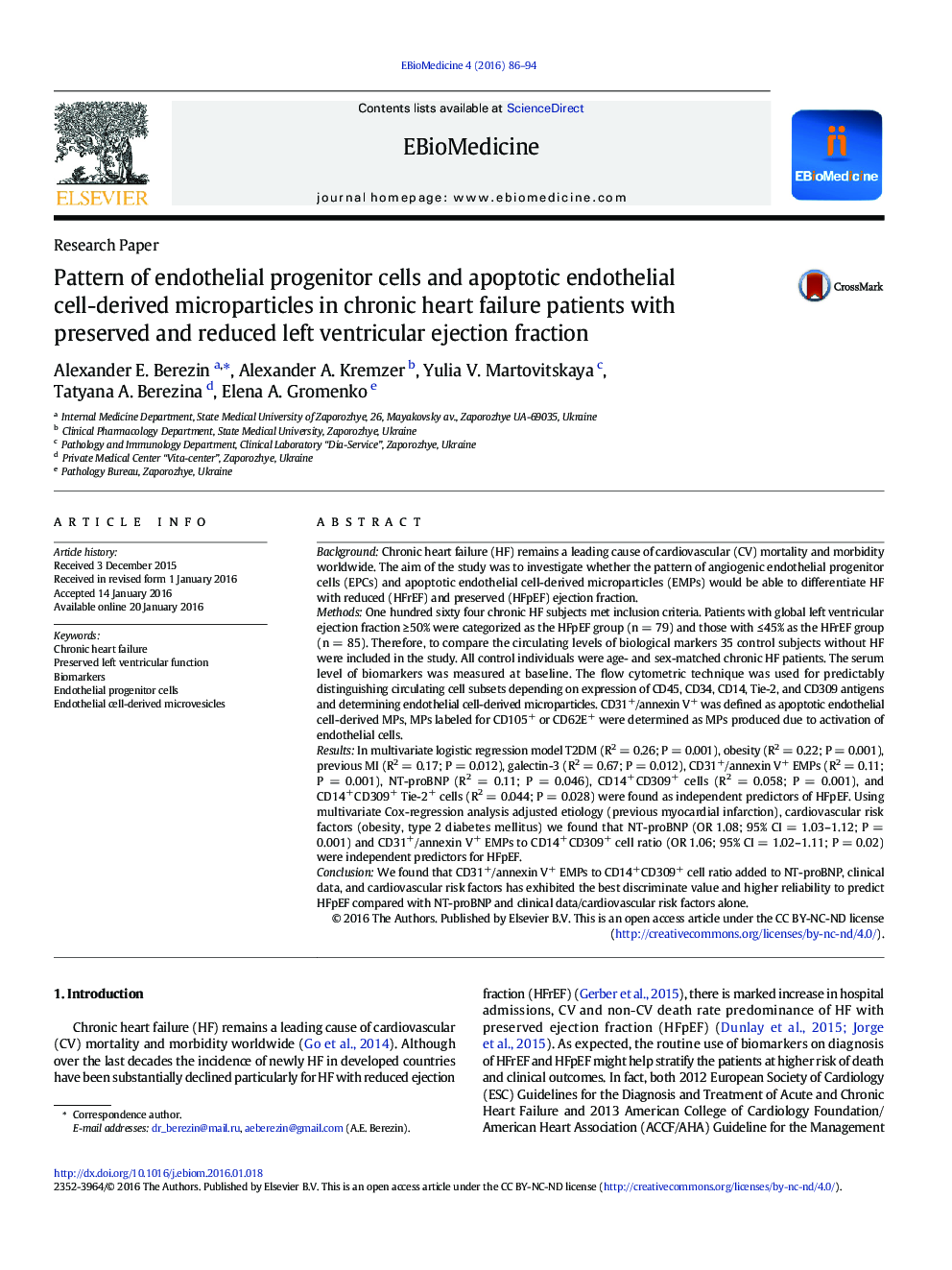| کد مقاله | کد نشریه | سال انتشار | مقاله انگلیسی | نسخه تمام متن |
|---|---|---|---|---|
| 2120797 | 1546895 | 2016 | 9 صفحه PDF | دانلود رایگان |
• Endothelial progenitors and apoptotic endothelial microparticles contribute in regulation of endothelial function
• Heart failure associates with decreased endothelial progenitors and increased apoptotic endothelial microparticles
• Imbalance between endothelial progenitors and apoptotic endothelial microparticles reflects impaired immune phenotype
• Endothelial progenitors to apoptotic endothelial microparticles ratio might be a surrogate predictor of heart failureWe have searched the clinical studies depicted predictive value of progenitor mononuclears and apoptotic endothelial microparticles in heart failure with preserved (HFpEF) and reduced (HFpEF) left ventricular ejection fraction. Our results have shown that simple measurement of circulating pool of endothelial-derived progenitor cells or apoptotic endothelial microparticles were not probably allowed to create novel model for risk stratification of patients with HEpEF. We suggest that CD31+/annexin V+ EMPs to CD14+ CD309+ cell ratio might be considered as an essential tool for prediction and individualized medical care of HFpEF patients.
BackgroundChronic heart failure (HF) remains a leading cause of cardiovascular (CV) mortality and morbidity worldwide. The aim of the study was to investigate whether the pattern of angiogenic endothelial progenitor cells (EPCs) and apoptotic endothelial cell-derived microparticles (EMPs) would be able to differentiate HF with reduced (HFrEF) and preserved (HFpEF) ejection fraction.MethodsOne hundred sixty four chronic HF subjects met inclusion criteria. Patients with global left ventricular ejection fraction ≥ 50% were categorized as the HFpEF group (n = 79) and those with ≤ 45% as the HFrEF group (n = 85). Therefore, to compare the circulating levels of biological markers 35 control subjects without HF were included in the study. All control individuals were age- and sex-matched chronic HF patients. The serum level of biomarkers was measured at baseline. The flow cytometric technique was used for predictably distinguishing circulating cell subsets depending on expression of CD45, CD34, CD14, Tie-2, and CD309 antigens and determining endothelial cell-derived microparticles. CD31+/annexin V+ was defined as apoptotic endothelial cell-derived MPs, MPs labeled for CD105+ or CD62E+ were determined as MPs produced due to activation of endothelial cells.ResultsIn multivariate logistic regression model T2DM (R2 = 0.26; P = 0.001), obesity (R2 = 0.22; P = 0.001), previous MI (R2 = 0.17; P = 0.012), galectin-3 (R2 = 0.67; P = 0.012), CD31+/annexin V+ EMPs (R2 = 0.11; P = 0.001), NT-proBNP (R2 = 0.11; P = 0.046), CD14+ CD309+ cells (R2 = 0.058; P = 0.001), and CD14+ СD309+ Tie-2+ cells (R2 = 0.044; P = 0.028) were found as independent predictors of HFpEF. Using multivariate Cox-regression analysis adjusted etiology (previous myocardial infarction), cardiovascular risk factors (obesity, type 2 diabetes mellitus) we found that NT-proBNP (OR 1.08; 95% CI = 1.03–1.12; P = 0.001) and CD31+/annexin V+ EMPs to CD14+ CD309+ cell ratio (OR 1.06; 95% CI = 1.02–1.11; P = 0.02) were independent predictors for HFpEF.ConclusionWe found that CD31+/annexin V+ EMPs to CD14+ CD309+ cell ratio added to NT-proBNP, clinical data, and cardiovascular risk factors has exhibited the best discriminate value and higher reliability to predict HFpEF compared with NT-proBNP and clinical data/cardiovascular risk factors alone.
Journal: EBioMedicine - Volume 4, February 2016, Pages 86–94
